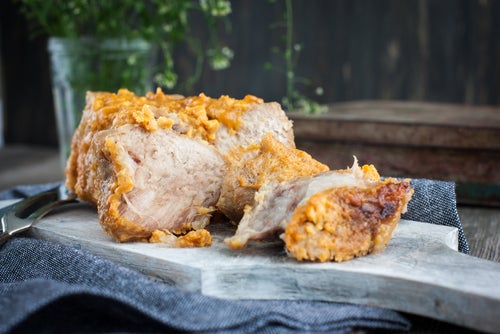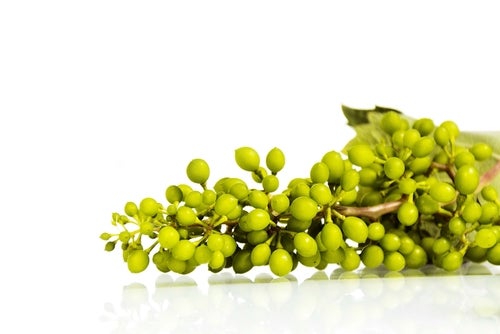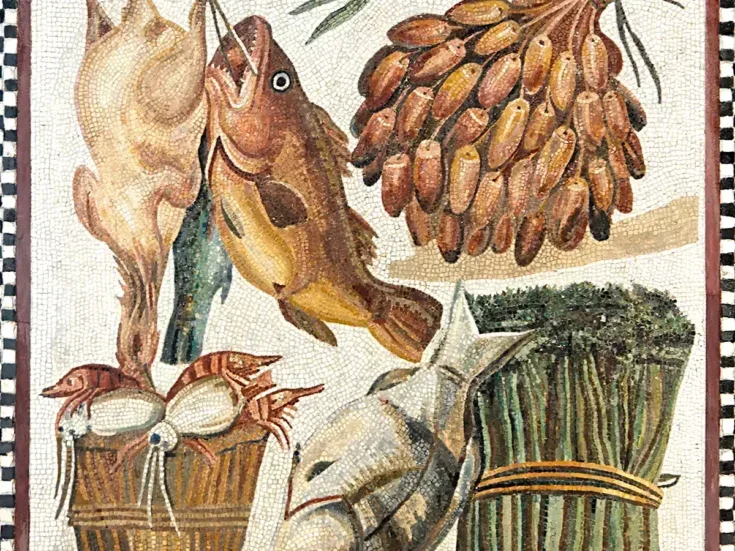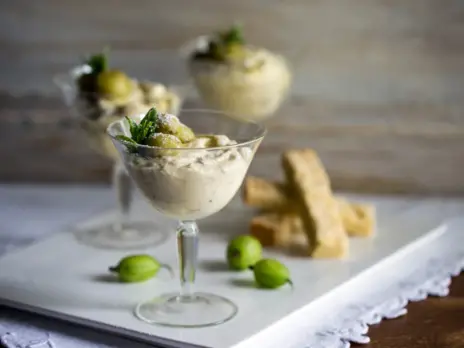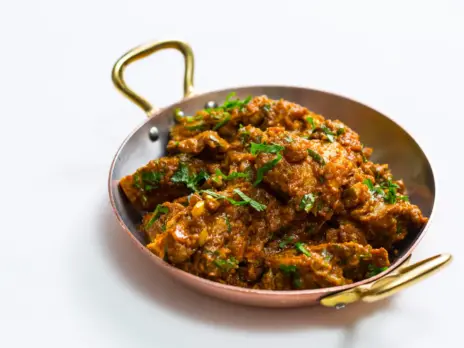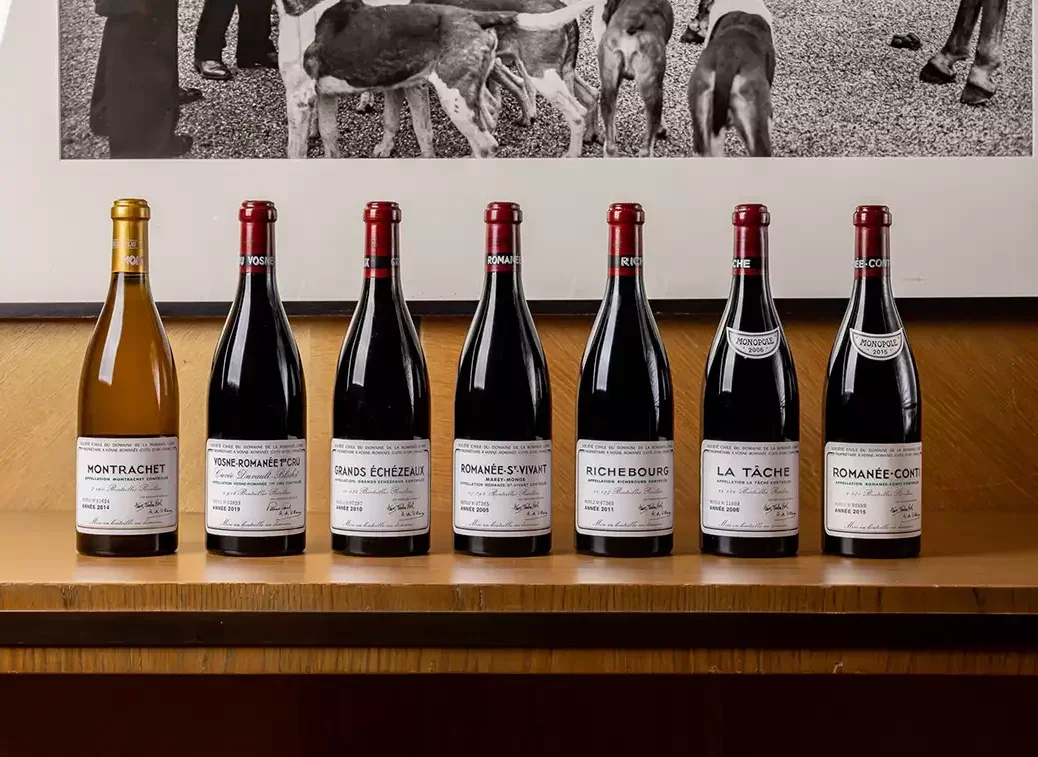
A dinner at London’s The Connaught Hotel featuring an array of mature vintages from Domaine de la Romanée-Conti paired with specially created dishes by chef Hélène Darroze turned out to be the most memorable wine and food occasion of Michael Schuster’s working life.
The genesis of this dinner, at The Connaught in London on December 11, 2024, dates back many years. Quite coincidentally, I was planning one with Daniel Manetti, global wine director of Maybourne, which owns the hotel, in the fall of 2019—then the Covid-19 lockdown scuppered it. I had nothing to do with the current occasion, inspired by a visit Daniel and his wine team made to Domaine de la Romanée-Conti last summer—other than being asked, at the last moment, whether I would like to cover it for The World of Fine Wine. Health issues notwithstanding, my wife Monika said, “Well, it’ll take you about two seconds to make up your mind on that!” Indeed. More to the point, it is part of The Connaught’s impressive program of wine and food events, featuring their relationships with many of the world’s finest wine producers, partnered with their restaurant’s cuisine under the direction of Hélène Darroze and the restaurant’s executive chef Marco Zampese.
Setting
The Connaught Hotel’s Maple Room. Thirty eager gourmets from a global sweep of climes around a single table. All ages: raven tops, salt and pepper, white hair. The “Informal Smart” dress code is variously interpreted as T-shirt, tie, skirts and dresses of every length, plus a standout silver-studded, black-leather punk. These were almost all regular patrons of The Connaught Hotel and Hélène Darroze’s restaurant there, where the Domaine’s wines have consistently been among the most sought-after selections. The long table, formal of course, but not stiffly so: a white linen tablecloth, and down the middle ten pale cream candles, holly leaves, holly berry reds, dahlia and late rose scarlets, ferns in both leaf greens, and the pale tans and tawnies of decay. A nod to December, Christmas, and Europe’s autumn. At each place was a dark claret envelope, silver-inscribed with a guest’s name, and a menu card enclosed.
Prologue
Very few hotels or restaurants offer Domaine de la Romanée-Conti wines by the glass, but it is something that The Connaught does. Not only was the Domaine an obvious choice for their fine wine and food program, but such a dedicated dinner was often suggested by regular diners in the restaurant. And the bringing together of the Domaine and consumers interested in top wines seemed an obvious if clearly not straightforward objective for all: the Domaine, its UK agents Corney & Barrow, the hotel and the restaurant. Planning began in the summer of 2024, with a visit to the Domaine and then consultation with Adam Brett-Smith, Corney & Barrow’s managing director, as to what wine lineup would make sense. The choice was guided by a combination of drinking windows and wines of which The Connaught had at least three bottles in the cellar. The wine and food pairings were then chosen according to the wine/vintage combinations and the dishes that Hélène, herself a considerable wine enthusiast, thought would best complement the wines in question.
Adam, too, had some observations by way of introduction: “This is an occasion to enjoy and talk about what the Domaine’s then director, Aubert de Villaine, called a necklace of vineyards with a single grape in common, Pinot Noir. Pinot’s transparency is an excellent medium of translation, of expression of the individual vineyard soils, their terroir, and the different vintages. I hate the obsession with so-called great versus poor vintages, for every year—and there are very different styles of vintages this evening—we will see diverse interpretations of the vineyards, each, as you will see, special in its own way. Finally, I want to stress that it’s worth trying each wine alone, in isolation, prior to having it with food, and to think of it as just a snapshot in time.”
Each wine was indeed poured before its accompanying course arrived, to provide time in isolation for that initial meeting.
Apéritif
2008 Billecart-Salmon Cuvée Nicolas François Billecart Brut
(12.5% ABV; magnum)
Pale lemon-yellow. A lovely, fresh, early bouquet, with a very subtle, nutty, autolysis character, persistent and refined. Medium-full, concentrated, vigorous, the typical slightly austere balance of the vintage, even with 60% Pinot Noir. Bone-dry, very fine in mousse texture, taut, lemony, appetizing; complex, long in the mouth, and with superb aromatic persistence. A satisfyingly complete, classy apéritif with, as you would expect of 2008, years to go and improve. Now to 2035. | 94
WINES AND FOOD: SIX MOVEMENTS
1. CAVIAR—Daurikus, Thousand Islets Lake; dashi jelly, sea herbs, oyster, sea urchin
Adam Brett-Smith:Montrachet’s reputation is as the greatest dry white wine in the world, so a lot to live up to. But this wine is always beautiful, be it at six months from barrel or 25 years in bottle. And 2014 was a very fine vintage for white Burgundy.
2014 Domaine de la Romanée-Conti Montrachet Grand Cru
(13% ABV)
Bright mid-gold; a refined, persistent early bouquet of roasted hazelnut, ripe white peach, minerals, and linden flower perfume—glass-filling, hauntingly complex, which you feel you can drink by smelling alone. A full, concentrated wine, vitally defined by its acidity, absolutely beautifully balanced; bone-dry, long, graceful, enormously tenacious across the palate, teeming with inner energy, with remarkable length of flavor to taste and a mouth-coating, minerally finish. A rich, taut wine, opulence contained by tension. All that one might want, indeed expect, of the summit of white Burgundy in this first-rate vintage. Infinitely rewarding now, decades to go. Now to 2044+. | 97+
As you can see, this first dish was small (as they all were), striking to behold, gold-leaf decorated, delicate. In essence, the large roed yet subtly brine-tasting Daurikus caviar on a bed of seaweed-scented dashi jelly. Marine-emphatic, abundantly redolent of the ocean on the palate, meaty in texture from the oyster, intense without being strong.
This was a wonderfully balanced pairing with the Montrachet, the dish itself having a remarkable length from its natural ingredients, absolutely to match that of the wine, and with all the scent and sensation of the 13% Chardonnay remaining, a combination of clarity, delicacy, and power in both wine and food. A great start.
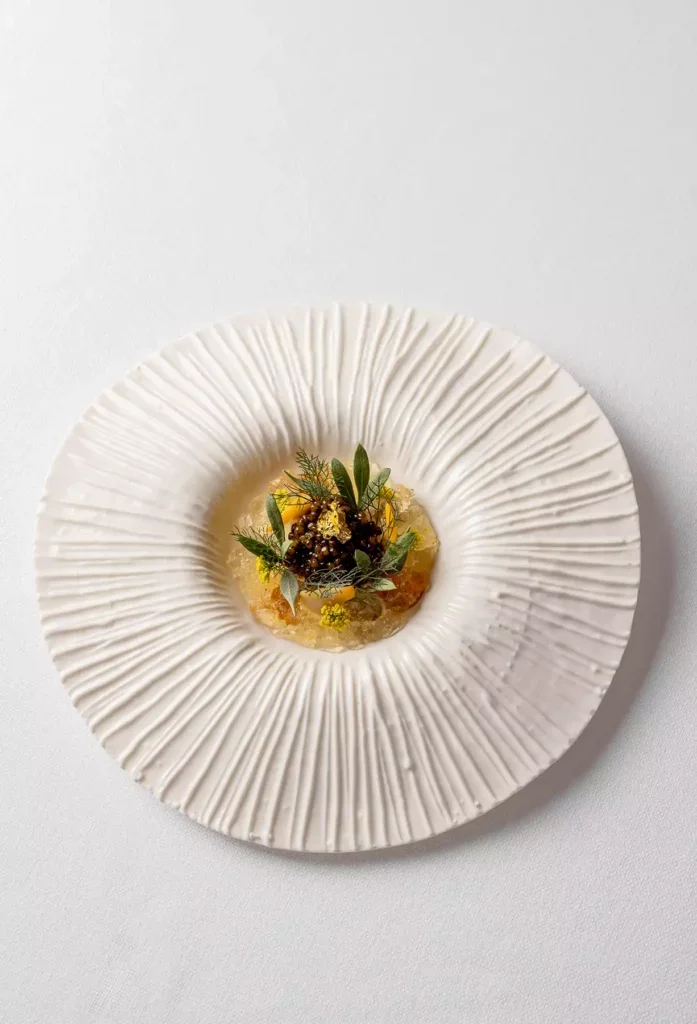
2. ONION—Cévennes, France; lomo ibérico, Fumaison, sourdough, lemon thyme
Adam Brett-Smith: 2019 was an easy, solar year, making for beautiful red Burgundies, and it was almost surreal that wines of such depth and power should also offer such sublime grace and freshness.
2019 Domaine de la Romanée-Conti Vosne-Romanée Premier Cru Cuvée Duvault-Blochet
(13.5% ABV)
Deepish, pale-rimmed red. An open and still very primary-fruit emphatic nose, sweetly ripe red cherry in character, with a remarkable presence for a “premier cru”—undoubtedly because it is a blend of declassified grands crus. It is made occasionally, from the Domaine’s young vines in abundant high-quality vintages and named for the Domaine’s 19th-century founder. This is medium-full but nicely concentrated, freshly defined, and very fine in already largely absorbed tannin—a lovely balance. Deep, sweet, fresh, succulently fruited, long, gently complex wine, with all the density of this great year; not that aromatically complex by DRC standards, as you would expect from the cuvée, but long and rewarding, with plenty of matter and fine length. Absolutely accessible and delightful already. Gloss, polish, real bouquet to come. Fine quality, with the very particular, dense, sappy qualities of this great vintage. And as it sat in the glass, such a glorious, sweet, rich bouquet developed. Now to 2039+. | 93
A quite magnificent rendition of France’s traditional “onion soup”. Both the Cevennes onions and the Fumaison cheese originate in the mountains of southern central France. The Cevennes onions are particularly sweet and delicate, slightly caramelized here, and the melting Fumaison cheese base has a fantastic scent, smoky in character, alongside the similarly smoke-imbued, salty Iberico ham; and all this intensity and richness was cut and complimented by the very clear lemon thyme aromas, and wonderfully “textured” by the wafer-thin, crisp, toasted feuilleté circles of sourdough—the most aristocratic of croutons! Onion soup? Hmm. This was a quite extraordinary conception of remarkable scent and complexity.
Once again, a modest portion, but so flavorsome. And it partnered the wine absolutely beautifully, the fresh, juicy, fruit-abundant Vosne a delightful foil to the rich onion soup. My South African neighbor said, “The pairing is genius.” Quite!
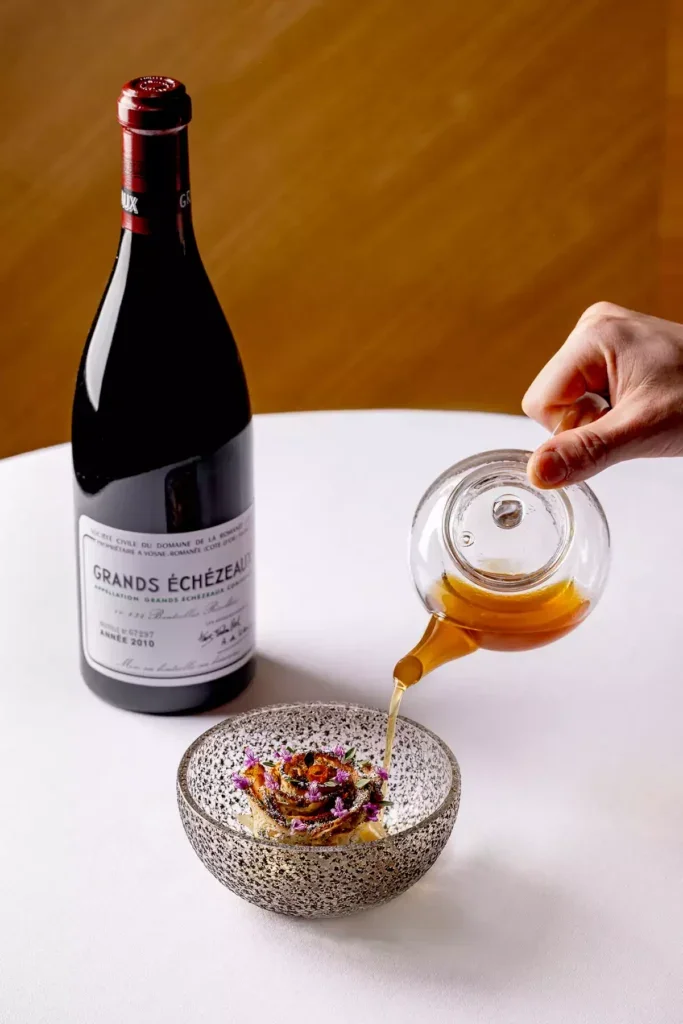
The “quite magnificent rendition of France’s traditional ‘onion soup,’” for which the 2019 Cuvée Duvault-Blochet was a “genius” match.
3. VEAL SWEETBREAD—Corrèze, France; parsnip, toasted rice, Vin Jaune d’Arbois
Hélène Darroze: Corrèze, in the central southwest, produces the best veal in France, with an ideal élevage.
Adam Brett-Smith: 2010 is perceived as great, but with the viticultural year described by Aubert de Villaine as a Homeric epic, difficult, chaotic, and saved by a beautiful September. There is a purity and beauty and terroir clarity here that is often missing in the really solar years, but the 2010s are sometimes still quite closed and tannic.
2010 Domaine de la Romanée-Conti Grands-Échézeaux Grand Cru
(13% ABV)
Mature, medium-depth, brick-edged ruby. It has a wonderfully seductive early if not yet fully fledged bouquet, currently quite earth-bound, “cool”: undergrowth, autumn leaf, and forest floor, with the slightly more red-fruit austerity of the year, very persistent to smell, as one might expect. Medium-full, finely tannic, fresh to vital in acidity, very nicely balanced, if still with a touch of youthful sinew. Freshly sweet, taut, and upright in character, the very fine tannin still gently grippy; long, finely lean, transparent, subtly aromatic, with a tension and the sort of cool beauty that are very 2010. Still a touch resistant in texture but packed with fruit intensity, long to taste, long to finish—that DRC completeness, if still just a touch stiff in bearing. Lovely all the same. Now (just) to 2040+. | 94
This was heady stuff. Intoxicating. The dish’s base was the tender, sweet veal contrasted with the crunchy texture of its toasted rice coating and the crack of parsnip crisps, all rendered giddily exhilarating by shavings of Italian white truffle, plus the intense and intensely succulent flavor from the wonderful, concentrated, glossy jus, sharply lemon-edged with the Vin Jaune reduction. Another smallish portion, but what a dish; what aromas, flavors, textures. I noted, “What a culinary imagination.” Exquisite.
The dish paired beautifully with the Grands-Échézeaux, whose slight 2010 austerity was softened, its fruit drawn out. A great combination, another most felicitous match.
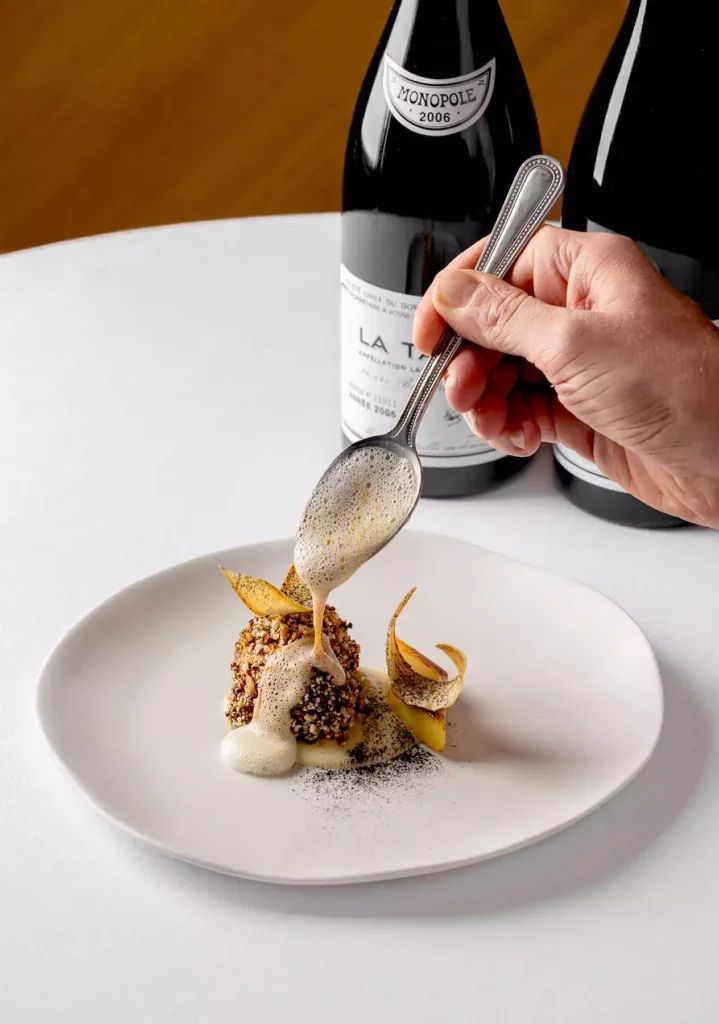
4. TURBOT—Newlyn, Cornwall;black pudding, topinambur, sorrel, Jerez vinegar
Adam Brett-Smith: All these wines in isolation are sublime, but next to each other you see the fascinating differences of vintage and vineyard. 2005 was a great year for red Burgundy, but the character of the long, dry, sunny summer imposed itself on the vines, making for long-term, structured wines that are in many cases still “clenched,” “compressed.” So much so that the thing I most remember about the launch of this vintage is that they seemed to be wines that deeply resented the imprisonment of bottling, feeling they needed more time to relax, to mellow in barrel.
2005 Domaine de la Romanée-Conti Romanée-St-Vivant Grand Cru
(13% ABV)
Deepish red, narrow-brick-rimmed. At nearly 20 years old, it has an astonishingly beautiful early bouquet, glass-filling, fragrant, complex, deeply, intensely black-cherry fruited and limestone-mineral fresh, an envelopingly heady fragrance, all that sweet fruit intermingled with hints of forest floor, leaf mold, autumn leaves; endlessly beguiling just to scent in the glass; a concentrated, medium-full wine, freshly defined, very finely tannic, just on the youthful side in texture, with the merest hint of oak and wood tannin still to feel, but overall a lovely balance—deep, succulent, fleshy cored, ample, and juicily ripe. Clear to sense are all the generosity and sunshine of 2005, with the very slightly youthful tannin presence of barely 20 years bottle-age in a top-notch year; magnificent core fruit, long, gently sappy, and with superb fruit and minerally limestone-tinged length; a really splendid RSV. To broach already, as we are doing this evening with great pleasure, if you really must—but there is alluring magnification to come, the bouquet alone showing the future promise of the palate. And the bouquet just continued to develop wondrously in the glass. Now to 2040+. | 94+
Tasting the 2005 DRCs for the first time in 2008, I wrote, “I cannot remember ever tasting young Burgundy with such aromatic intensity and persistence. You sense these are wines that you will be able to ‘drink’ just by inhaling. Already their fond de verre scents, coating the empty glass, are as powerful and tenacious as those of fine Madeira. If perfume is the essence of DRC wines, these are quintessential.” And exactly thus the Romanée-St-Vivant performs today.
This was as much of a delight on the eye as the first three courses, a gratifying reminder, were it needed, that we eat with our eyes, too, and all these dishes have been so beautifully presented. A fish dish, yes, but almost as firmly fleshed and protein rich as the venison to follow. “An element of surf and turf” was how the kitchen put it. So the small, firmly textured Turbot tranche was accompanied, appropriately, by two “meaty” sauces: a black-pudding purée on which, as a counterpoint, sat the superfine, crunchy Jerusalem artichoke crisps; and an intensely flavored, superbly glossy reduction, given cut by the Sherry vinegar, about which my neighbor observed, “This sauce needs fine sourdough bread as a ‘moppage device.’” I liked that, and the bread was right there to hand.
The rich black-pudding purée absorbed the slight tannin dryness of the wine on its own and revealed the Romanée-St-Vivant’s glorious fruit core—another almost exhaustingly rewarding marriage.
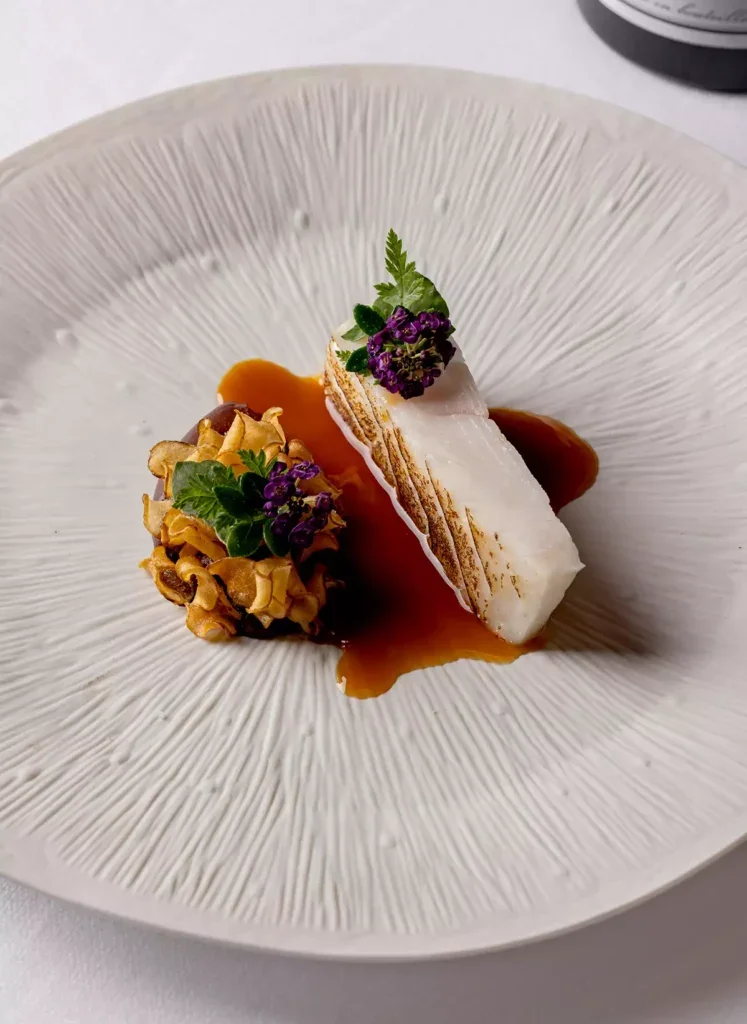
5. VENISON WELLINGTON—Rhug Estate organic farm, North Wales; smoked eel, beetroot, quince, “poivrade jus”
Adam Brett-Smith: Aubert called 2011 his most difficult year to date. But the more difficult years, the so-called lesser vintages, often give more satisfaction earlier. And here the difference between the vintage perception (lesser) and the tasting reality today (you will see) is particularly interesting. 2006 was an uneven vintage for the reds, but it was at its best, indeed it was very fine, in Vosne-Romanée—with what I call here a calm density, “terrestrial,” as distinct from the 2015 Romanée-Conti’s “aerial” character, for example.
2011 Domaine de la Romanée-Conti Richebourg Grand Cru
(13% ABV)
Medium depth, mid-red, narrow brick-rimmed, indications of early maturity. Still a touch tight to smell, but incipient tertiary characters there, with a bit of glass swirling; a density of cooler, earthbound fruit, as though you sense the clay dominance in the vineyard. The palate, by contrast with the 2005 Romanée-St-Vivant, is much more immediately expressive; full, rich, still quite firmly but finely tannic; deep, sweet, gently muscular, with plenty of Richebourg “matter,” presence, bearing—a mouth-coating and searching character alongside the sweetly ripe, red fruit. Long, refined, typically Richebourg dense in style, a lovely core here, long and rewarding to taste in this slightly cooler year, and with fine length to finish. Here the expression is all on the palate, with all to come on the nose, in absolute contrast to the 2005 Romanée-St-Vivant. Great pleasure now, decades in hand. Now to 2045. | 94
2006 Domaine de la Romanée-Conti La Tâche Grand Cru Monopole
(13% ABV)
Medium depth, mature, brick-edged ruby. Initially surprisingly tight and closed to smell, with none of the La Tâche spice fireworks immediately in evidence. Subtly red-cherry ripe, persistent, mineral-marked, but shy, needing time and encouragement in the glass. A lovely red-fruit perfume emerges as it sits and you swirl—plenty to tempt and to tempt you to linger, the La Tâche extravagance emerging. On the palate, like the Richebourg, this is immediately flattering to taste, full, fresh, very fine in mostly absorbed tannin, deep, sweet, racy, complex, and spicy, very come-hither and appealing, just full of perfume and fruit. Transparent, graceful, intense in flavor, palate-searching, long, rewarding, and with a wonderful length of aftertaste. A (perhaps surprising?) star in tonight’s lineup. All the more when the bouquet opened up as it sat in the glass. This then became a truly beautiful wine, so sweet and seductive to smell, taste, and finish. Ravishingly perfumed, and completely different from the more reserved density of the adjacent Richebourg. Glorious. A magical encounter with this 18-year-old. Now to 2036+. | 96
In many ways, this was the most mature, complete, and beautiful wine of the evening. Well, that was before the haunting but barely mature 2015 Romanée-Conti itself…
This, again, was such a complex dish. Just a single slice of the venison fillet, so pink and tender, duxelles-pâté-coated and shortcrust-pastry-cased. And a sublime sauce: the thickened juices from the venison trimmings and bones, infused with intensely smoky aromas from the eel, sharpened with the sweet, lemony flavors of quince, some pieces cooked in quince vinegar, firm and grainy textured. This intricate, elaborate assemblage another gloriously glossy reduction, poivrade pepper-spiced, with, on the plate, the additional contrast of small, sweet, vivid, al dente beetroot. Phew!
So, how did the DRC’s fare? The gentle muscularity of the Richebourg and its abundant fruit kernel were a perfect foil to all this, with plenty of wine presence to taste. As for La Tâche, with time in the glass it tasted so fragrant and subtle, with a delicacy and sweetness so intense it seemed to soar above the dish, as an enhancement, not a detraction. Additional dimensions of sensation, really rather remarkable.
6. VACHERIN MONT D’OR—Jura Vaudois, Switzerland; black truffle from Périgord, ratte potato, puntarelle, tardivo
Adam Brett-Smith: 2015 was described by Aubert as an easy, sunny vintage, where Romanée-Conti transports me, at least, weightlessly to heaven. And don’t let the wine go anywhere near the cheese!
2015 Domaine de la Romanée-Conti La Romanée-Conti Grand Cru
(14% ABV)
Deepish red, with an early brick-rimmed maturity. An intense, subtle perfume to smell—sweet, fragrant, spicy, exotic—mesmerizing, unaccountable. Multifaceted just to “scent,” brimming the glass, and immediately of a different order of complexity and scope from even the beautiful 2006 La Tâche. Fragrance apart, this is emphatically black-fruit ripe in character, heady, complex, mineral-touched. To taste, it is full, concentrated, finely tannic, still somewhat youthfully tight in texture, but also ample, fleshy, very marked by a pronounced inner energy and “race” on the palate, prolonged and intense, but a power that is quietly expressed, with all the delicacy and transparency of the finest Burgundy. A gorgeous, sweet, fruit succulence underlies the aromatic wealth and complexity, and the finish is a pronounced and lingering flourish of all the peacock’s-tail spice and scent you would expect. Radiantly beautiful, absolutely effortless. It is an extremely rare privilege to drink any Romanée-Conti, and this was immensely rewarding to ponder, to savor, to relish, all the more remarkable for being a bare ten years of age. With decades of increasing subtlety, bouquet, polish to come. Now to 2055+. | 97+
Describing the vineyards in September 2015, Aubert de Villaine, the Domaine’s director at the time, said, “I was struck by their beauty, and by the perfect health of the vines, their leaves, their fruit—and the wines seem to reflect this easy, sunny, unstressed character. Serene, peaceful.” Exactly so. And Adam’s comment days later was, “I’m still tasting that Romanée-Conti 2015, which surely was touched by God…”
As to whether to serve Romanée-Conti with cheese at all, and if so whether a cheese like Vacherin is a good choice, Richard Olney in his book Romanée-Conti (Rizzoli, 1995) makes some salient points that I couldn’t put better: “The alliance of the Domaine’s wines with cheeses is not necessarily of the sort that inspires each, in the presence of the other, to soar to new heights of eloquence. Romanée-Conti is most often poured with the cheese course, not because it is a marriage made in heaven but simply because, in the context of a traditional modern menu, the climax of a suite of red wines coincides with the cheese service.” And later: “a sliver of Maroilles or Livarot […] can wreak havoc with a Romanée-Conti”—two cheeses for which you could substitute Vacherin, another soft, strong, pungent, washed-rind cow’s-milk cheese. A little further on, he quotes Lucien Peyraud of Domaine Tempier in Bandol: “It’s a crime to drink Romanée-Conti while eating—it has to be analyzed with joy in all its fullness.”
To serve a Vacherin Mont d’Or in December is understandable—this is its moment, when it is at its best. And it is indeed splendid on its own, with toasted wholemeal bread or fresh baguette. Even better, as on this occasion, baked and suffused with black truffle, then set off with the crisp textures and slight bitterness associated with both puntarelle and tardivo leaf salads.
But its pungency apart, Vacherin’s glutinous texture so coats the palate and lining of the mouth and so clogs the taste buds as to render the perception of aromas and perception of the wine’s particularly delicious and delicate textures all but impossible.
La Romanée-Conti and Vacherin Mont d’Or are both pinnacles of their kind, each magnificent in its own right. And while I suspect that even Penfolds Grange might have its work cut out to partner a Vacherin, it is certainly utterly inimical to the exquisitely intense, yet diaphanous qualities of a Romanée-Conti.
Romanee-Conti is the most rarefied of the DRC wines. For all its intensity, there is a fragility to its power, and its myriad, subtle beauties are all too easily masked by food of practically any kind. An opportunity like tonight’s, to actually drink the wine, is likely to be almost unique for most people. Indeed, the vast majority of my wine-writing and wine-trade colleagues, worldwide, will never even have tasted it, let alone shared a bottle with friends. I myself have only drunk it in company on two occasions, the 1980 on the eve of my wedding to Monika in 1991, and this evening’s 2015—a production of all of 403 dozen (4,836 bottles). Not to maximize one’s enjoyment of every facet of what is available in your glass, on its own, would be a tragic, missed opportunity. Each drop should be contemplated and savored, partly in company, partly in a solipsistic reverie of rapture.
This then, was the only mismatch, in my view, on an evening otherwise of marriages indeed made in heaven.
What are we to make of this?
Events such as this are rare. To carry them off with aplomb, even rarer. For the combining of great wine and great food is not, as the French put it, evident. It was by no means a given that such a complex, high-stakes event would work successfully. High stakes not only because of the cost of the wines and food being served but also because, understandably, of sky-high expectations. That it did work successfully was remarkable. An all-round triumph. Great wines, simple food is the mantra. But Hélène Darroze demonstrated that this is emphatically not necessarily the case. You don’t have to have simple food; you have to have cuisine with aromas, flavors, and textures that are not too strong or dominant for the wine in question. A challenge, certainly, but Hélène and Marco, in the heat of the kitchen, more than rose to it. The wines and the food were sensational, individually and in combination.
This was, in effect, a huge collective effort: two great creative teams working with natural ingredients—Domaine de la Romanée-Conti and Hélène’s kitchen brigade, choreographed in combination by a third joint team of Corney & Barrow and The Connaught staff. That it worked as well as it did is an achievement of extraordinary proportions when you consider the number of things that could have gone wrong, been less than perfect—but that didn’t, that weren’t.
The evening seemed in many ways symphonic, an array of sensations within six vinous-culinary movements, with a thematic coherence of—an emphasis on—origin, be it wine or food. Between movements, between each course, there was a moment of stillness. A pause to allow the ringmasters, Hélène and Adam, to give an introduction, occasionally a retrospective, to what had been, or was about to be poured or set before us. A moment of quiet, with guidance as to origins, vocabulary, what to look out for, before the orchestral murmur of round-table discourse resumed. Exclamations of surprise, delight, appreciation, of astonishment. Pleasures, sensations, unimaginable, unimagined. Grasped by contemplation, enhanced by sharing.
Effortless implementation was the hallmark of the evening. An inconspicuous, balletic fluency of service, where the opportunities for misstep were boundless, but no one faltered. There was a quiet, unobtrusive rhythm: clearing glasses, filling glasses, the next Zalto-cradled cru; clearing plates, fresh flatware, the next dish. The ensuing movement a fresh focus, the pleasure of rhythm and repetition with the embellishment of variation.
You barely noticed the Connaught team in their pale emerald-green suits, pouring, serving, ministering. Enablers with years of practice. Daniel Manetti the conductor, overall régisseur. This sort of perfection doesn’t happen by chance. It is born of a concept, a vision, a culture, and an investment in time and money that take years to develop, and that entail, above all, an infinite attention to detail. Fine dining as an art, and on this occasion almost operatic in scope, in its combining of disciplines.
But there was a measured beauty to tonight’s performance. Extravagant of course, yet neither unduly abundant nor excessive. Each dish was beautiful but small. Over the four or so hours (we sat down at 7:15pm, rose at around 11:15), each of us had drunk barely three quarters of a bottle, but of exquisite quality, our senses caressed, never assaulted. It was a civilizing, elbow-to-elbow, attentively shared pleasure. Enriching, life-enhancing. Privileged, too, of course.
Just as the food service was impeccable, so, too, was the service of wine. Crucial. All too rare. And another instance of exemplary attention to detail, in this case by the hotel’s head sommelier Lucas Reynot-Paligot. The red wines for the evening were stored in a small annex adjacent to the Maple Room, at 57°F (14°C), so that by the time the wine was in the glass, ready to sample, it would be around 61°F (16°C), ideal for red Burgundy to start with. And very much replicating what happens at the Domaine, where they bring the bottles up from the cellar just before the meal. No decanting—also reflecting Burgundian practice. The bottles had been standing up for some time; the relative youth of the vintages meant there was little deposit, and cautious, vigilant pouring took care of the rest.
Expensive? Yes, luxuries are. Was there anyone present who didn’t consider that they got value for money, in every respect? I doubt it. I was—we were—utterly spoiled, by the wines, the food, the service, and, indeed, the sense of occasion. It was an astonishing overall performance. Without the actual experience, I would not have believed it possible. It was unquestionably the most memorable wine and food occasion of my working life.

